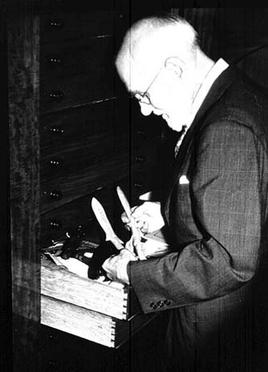A. W. F. Fuller facts for kids
Alfred Walter Francis Fuller (born March 29, 1882 – died December 13, 1961) was a British expert who studied human cultures and collected many items from different parts of the world. He is most famous for his huge collection of over 6,800 items from the Pacific region. This amazing collection is now kept at the Field Museum in Chicago, USA.
Contents
Early Life and School
Alfred Fuller was born in 1882 in a place called Sussex in England. His father was a reverend. Alfred went to a school called Dulwich College.
His Career and War Service
Alfred Fuller first became a lawyer. But when World War I started, he joined the army. He became a captain in the Oxfordshire and Buckinghamshire Light Infantry and fought in a place called the Salonika front. He was in battles in Bulgaria. By 1918, he had to leave the army because he became ill.
Collecting Amazing Artifacts
Alfred Fuller was always very interested in anthropology, which is the study of human societies and cultures. After the war, he started collecting on a very large scale. He mostly bought items from auctions and from local museums that were closing down.
In 1924, he married Estelle Cleverly. Together, they continued to grow the collection and also built a huge library with more than 20,000 books! He even volunteered at the British Museum for a while. He was also a member of the Royal Anthropological Institute, a group for anthropology experts.
Fuller never wanted to sell his collected items. He only made one sale in his whole life. This was in 1958, not long before he passed away. He sold over 6,800 items from the Pacific to the Field Museum in Chicago for £40,000. That amount would be worth a lot more money today!
After he died in 1961, his wife sold the rest of his collection. His large library was later bought by the Bishop Museum in Hawaii.
Fuller's Collection at the Field Museum
Over his lifetime, Alfred Fuller gathered a huge collection of items from Polynesia, a region in the Pacific Ocean. The Field Museum bought about 6,885 of these items from the Fullers. Later, Fuller's wife also gave about 300 more items to the museum.
Fuller spent 62 years building this collection. He was always buying and trading items in Britain. During his time, it was common for many Polynesian items to be brought to Great Britain.
Even though Fuller never actually visited Polynesia, he got his items in many ways:
- He bought them from private homes.
- He bought them when museums sold off their extra items.
- He found them at auctions.
- He bought them from special shops that sold old and rare items.
Sometimes, he would trade an item he had for another item that fit better into his collection. Many items also came to Britain because of missionaries, who traveled to the Polynesian world. Other items came from the private collections of army officers. He loved finding valuable items in antique shops for a low price because the shop owner didn't know their true worth!
Fuller was very dedicated to his collection. He wanted to have many different versions of the same object to show how technology changed over time. He studied and compared each item carefully. He wanted to get the most complete picture possible of these objects.
Because he never visited Polynesia but still collected so much important information, he was sometimes called an "armchair anthropologist." This means he learned a lot about cultures without traveling to them.
When he got older, Fuller decided he wanted a museum to keep his collection safe. A friend helped him connect with the Field Museum. In the 1950s, he sold his collection to them. He didn't want to sell at first, but he agreed to the price of £40,000. He wanted this money to help his daughter after he was gone.
A very important part of the deal was that the museum agreed to keep the entire collection together. Fuller wanted scientists to have a complete set of items to study and learn about old Polynesian societies. When they were discussing the sale, Fuller told a museum representative named Roland W. Force stories about how he got each item, when he got it, and where it came from. The museum still has recordings of these conversations!
Images for kids
-
Iuhi tattooing needles from Easter Island, given to the Field Museum by Fuller.
-
HMS Resolution and Discovery and Tahiti, a painting by John Cleveley the Younger (around 1770-1790). This painting was also given by Fuller.
See Also




